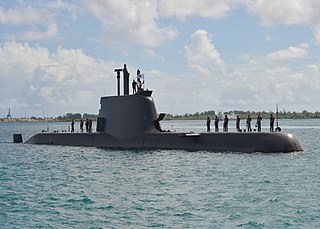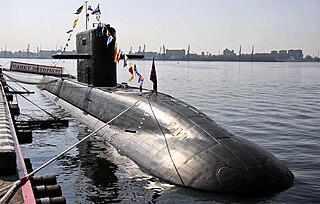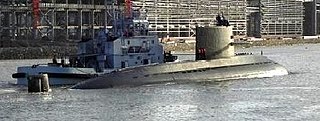
The Type 212A is a class of diesel-electric submarine developed by Howaldtswerke-Deutsche Werft AG (HDW) for the German Navy, and the Italian Navy where it is known as the Todaro class. It features diesel propulsion and an additional air-independent propulsion (AIP) system using Siemens proton-exchange membrane (PEM) compressed hydrogen fuel cells. The submarines can operate at high speed on diesel power or switch to the AIP system for silent slow cruising, staying submerged for up to three weeks with little exhaust heat. The system is also said to be vibration-free and virtually undetectable.

The Swedish Navy is the naval branch of the Swedish Armed Forces. It is composed of surface and submarine naval units – the Fleet – as well as marine units, the Amphibious Corps.

The Visby class is a series of corvettes in use by the Swedish Navy. It is the latest class of corvette adopted by the navy after the Göteborg and Stockholm-class corvettes. Its design emphasizes low visibility radar cross-section and infrared signature, and the class has received widespread international attention because of its capabilities as a stealth ship. The first ship in the class is named after Visby, the main city on the island of Gotland.

The Type 214 is a class of diesel-electric submarines developed exclusively for export by Howaldtswerke-Deutsche Werft GmbH (HDW). It features diesel propulsion with an air-independent propulsion (AIP) system using Siemens polymer electrolyte membrane (PEM) hydrogen fuel cells. The class combines the design principles of the Type 209 submarine family and the features of the Type 212A submarine. However, as an export design, it lacks some of the classified technologies of the Type 212 such as the non-magnetic steel hull that makes it difficult to detect using a magnetic anomaly detector.

Saab Kockums AB is a shipyard headquartered in Malmö, Sweden, owned by the Swedish defence company Saab Group. Saab Kockums AB is further operational in Muskö, Docksta, and Karlskrona. While having a history of civil vessel construction, Kockums' most renowned activity is the fabrication of military corvettes and submarines.

HSwMS Gotland (Gtd) is a defense submarine of the Swedish Navy. It was the first ship of the Gotland-class, which was the first operational submarine class in the world to use air-independent propulsion in the form of Stirling engines which use liquid oxygen and diesel as the propellant.

The Scorpène-class submarines are a class of diesel-electric attack submarines jointly developed by the French Naval Group and the Spanish company Navantia. It features diesel propulsion and an additional air-independent propulsion (AIP). It is now marketed as the Scorpène 2000.

The Swedish Södermanland class of diesel-electric submarines consists of HSwMS Södermanland and HSwMS Östergötland. These two submarines were originally launched as Västergötland-class submarines in 1987 and 1990, and were relaunched as a new class after extensive modernization in 2003 and 2004 by Kockums AB. The pressure hull had been cut in two after the sail and a 12 m long new section with an air-independent propulsion system was inserted. It contains two Stirling engines which are coupled to electric generators and heated by burning diesel fuel with liquid oxygen stored in cryogenic tanks. The AIP system can provide electric energy to extend the submarine's submerged time from days to weeks.

The Gotland-class submarines of the Swedish Navy are modern diesel-electric submarines, which were designed and built by the Kockums shipyard in Sweden. They are the first submarines in the world to feature a Stirling engine air-independent propulsion (AIP) system, which extends their underwater endurance from a few days to weeks. This capability had previously only been available with nuclear-powered submarines.

Lada class, Russian designation Project 677 Lada is the new advanced class of diesel-electric attack submarine designed by the Russian Rubin Design Bureau. A program to develop a "fourth generation" diesel-electric submarine, it aimed to produce a highly improved version of the Project 636 with better acoustic signature, new combat systems and possibly air-independent propulsion. However, in 2019, Alexander Buzakov, the head of the Admiralty Shipyard, indicated that there were no plans to equip the Lada class with an air-independent propulsion system. In July 2022 it was reported that work on an electrochemical generator to produce hydrogen from diesel fuel and oxygen was continuing and that the Rubin Central Design Bureau signed a new contract in 2019 to continue work. This was scheduled to be completed by the mid-2020s. In 2023, the decision was taken to decommission and scrap the lead ship of the class, the Sankt Peterburg due to the very high costs of modernising the submarine.

The Type 039A submarine is a class of diesel-electric submarine in China's People's Liberation Army Navy. It is China's first AIP powered submarine and presumed to be one of the quietest diesel-electric submarine classes in service. This class is the successor of the Type 039 submarine. The official Chinese designation is 039A as the ship is based on the 039 class, but as the 039A has very little resemblance to the 039 it is commonly referred to as the Type 041. The class is designed to replace the aging Type 033 and the older Type 035 submarines that previously formed the backbone of the conventional submarine force.

The Sōryū-class submarines (16SS) are diesel-electric attack submarines. The first boat in the class entered service with the Japan Maritime Self-Defense Force in 2009. The design is an evolution of the Oyashio-class submarine, from which it can most easily be distinguished by its X-shaped stern combination diving planes and rudders. The Sōryūs have the largest displacement of any submarine used by post-war Japan.

The S-80 Plus class is a Spanish class of four submarines being built by the state-owned Spanish company Navantia at its Cartagena shipyard for the Spanish Navy. In common with other contemporary submarines, they feature air-independent propulsion.
HSwMS Artemis is a signals intelligence gathering vessel currently in service for the Swedish Navy.

The Taigei-class submarines (29SS) (Japanese: たいげい, "Big Whale") is a new class of attack submarines after 2022, developed for the Japan Maritime Self-Defense Force. It is the successor to the Sōryū class.
The Type 212CD class is a submarine class developed by ThyssenKrupp Marine Systems (TKMS) for the Norwegian and German navies. The class is derived from the Type 212 submarine class, but will be significantly larger than the 212 class.
The Dakar-class submarine is a class of AIP-capable, diesel-electric attack submarines ordered by the Israeli Navy from German-based naval conglomerate ThyssenKrupp Marine Systems (TKMS).

The Orka-class submarine is a future submarine class currently planned for the Royal Netherlands Navy. The submarines will replace the aging Walrus class.
The Luleå class is a Swedish corvette class under development. In total four ships are planned to be built by Saab Kockums. The first two ships are to be commissioned by 2030 and two more by 2035. In June 2023 it was announced that the ships would receive names after Swedish coastal cities:













